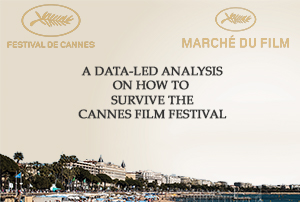 The Cannes Film Festival and Market are just around the corner. It’s a mad mix of five-star movies, five-minute meetings and five-Euro bottles of water.
The Cannes Film Festival and Market are just around the corner. It’s a mad mix of five-star movies, five-minute meetings and five-Euro bottles of water.
To help attendees get the most out of their trip, I have gone through my archives of Cannes research, and conducted some new research, to see what a data-led analysis can reveal.
I’ve boiled down the key points to just eight main takeaways, with links to explore each in more detail.
1. The opening weekend is the time to be there
Over the years, I have conducted numerous studies into when people attend top film festivals and the opening weekend always comes out on top. This year that means the 18th and 19th of May.
In 2016, I interviewed 575 Cannes veterans to collect a long list of tips for attending the Cannes Film Festival. Their attendance plans are revealed below, showing just how much attendance drops off after the first weekend.
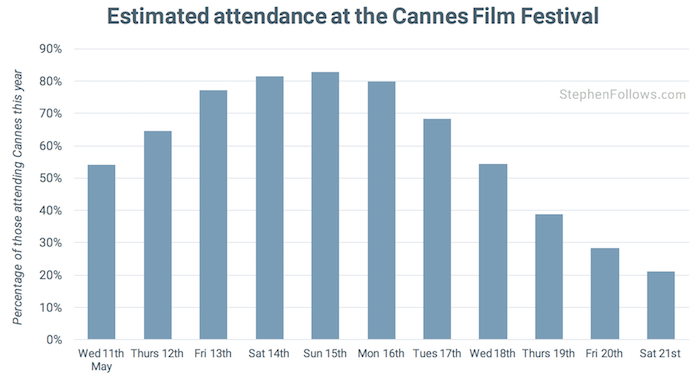
That study also showed that film buyers (i.e. distributors looking to acquire films) arrive earlier than most while film financiers tend to arrive later.
Further reading: Ultimate tips for attending the Cannes Film Festival.
2. Don’t worry if you miss a shortlisted movie as the vast majority make it to public cinemas
Movies nominated in Cannes have rarely been seen by anyone outside the core filmmaking team, meaning that ‘the buzz’ about a new movie can get out of hand. Without critical or audience reviews, the rumour mill goes into overdrive and everyone tries to get tickets for the small number of screenings. This can mean that you can leave Cannes having missed out on some hot new movies.
But, fear not, there’s a high chance the movie will get a public theatrical release.
Over the past three decades, the number of Cannes-nominated films reaching UK and US cinemas has increased. In 1990, only 56% of these films were shown in UK cinemas and 67% reached US cinema audiences. Compare that to 2015, when all of them reached US cinemas, and 84% made it to UK cinemas.
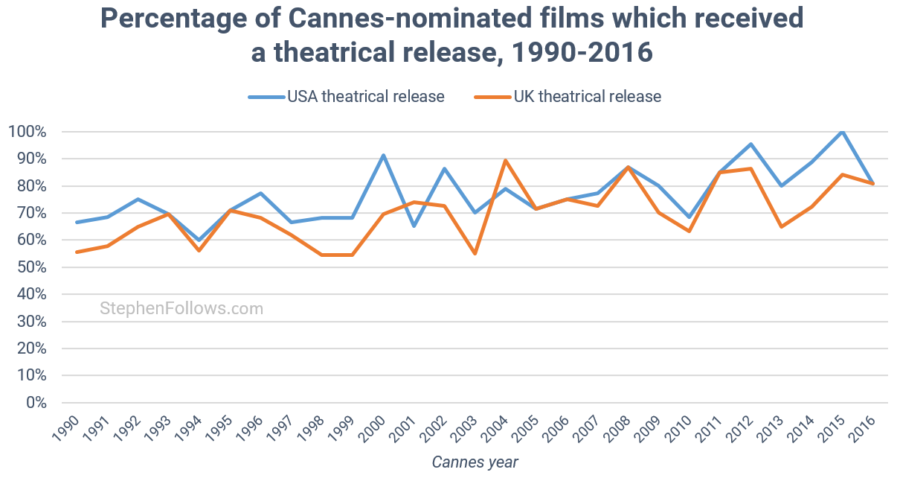
That said, the eventual theatrical release is likely to be a long time after Cannes and may not be in a cinema near you. The average delay between Cannes and the US theatrical release for Cannes-nominated films was 286 days (or nine and half months). Plus, over half will be released on fewer than 50 screens in the US.
Further reading: How many Cannes-nominated films get a theatrical release? and How many festival-nominated movies get theatrical distribution?
3. Cannes is expensive for everyone, but most of all for those selling
It’s possible for cash-strapped European filmmakers to attend Cannes fairly cheaply. Low-cost fights, taxi pooling, camping or staying one town over and eating from supermarkets can make a trip cost under €500.
However, those who have movies to sell have far fewer option to save money (without losing face). Having an official base from which to preview your movies and negotiate deals start in the tens of thousands of Euros and can quickly move up to hundreds of thousands.
As well as paying your staff, flying them to Cannes and feeding them, here are some options for your Cannes office:
- The smallest booth in the least desirable part of the market (9m2 in the Palais -1) starts at €4,650.
- You’ll then need to advertise your movies, which can range from just a few thousand Euro up to €30,000 for a poster outside the Palais, the main building.
- Some sales agents choose to take over a hotel room in one of the major hotels, stripping out the beds and turning it into an impromptu office. A night in The Grand hotel will set you back €980 during the festival (the same room a week earlier is half the price). Likewise, staying in a standard room at The Majestic during the festival costs €815 per night, whereas in the week before the festival it’s just €205 per night.
- It’s not just those selling movies who pay big bucks to be seen in Cannes. Along the beach are a row of pavilions, promoting different regions of the world. The official list price for a small pavilion (25m2 inside and the same again for a beach-front terrace) is €17,025. But that’s just the ten-day rent; after that, you’ll need to furnish, staff and supply the tent. Between 2012 and 2016, the British Pavilion cost an average of £390,000 per year to run.
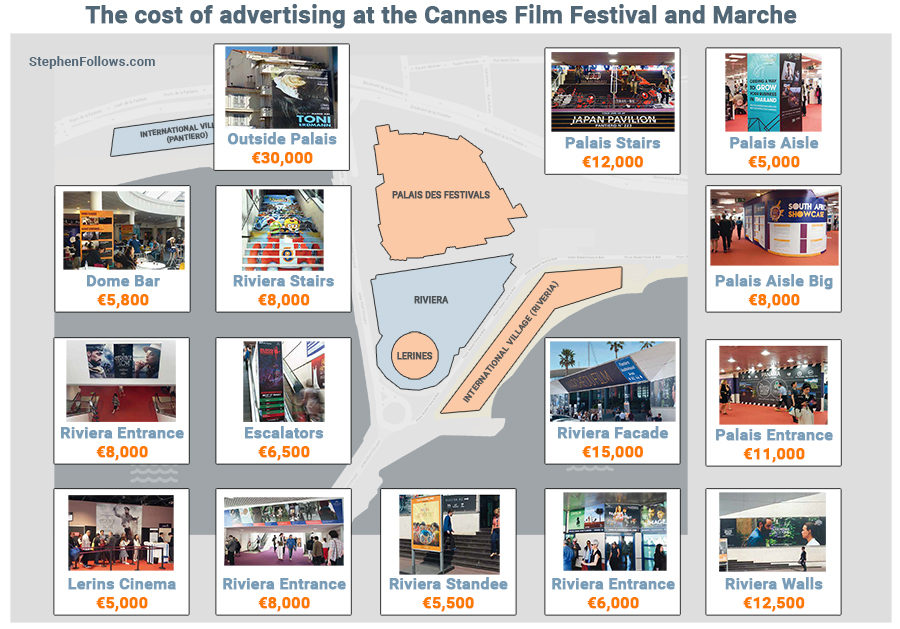
Further reading: How much does it cost to exhibit at the Cannes Marché?
4. Some of the ways Cannes works are downright bizarre
If you’re going to be attending for the first time, it’s worth reading up on how Cannes works. Much of the rules and customs everyone follows are strange and far from common sense.
Among the Cannes contradictions are:
- Many movies on sale have not been made, and never will be. (See: Can all these films really exist?)
- Deals struck in Cannes are often not actually struck in Cannes. (See: How can everyone be doing deals so quickly?)
- It looks like everyone is having so much fun but many film professionals hate going to Cannes. (See: Filmmakers have fun, Distributors don’t)
- It’s all about meeting people, but last-minute meetings are tricky to get. (See: Network, network, network and Set up your meetings in advance)
- At the world’s great celebration of filmmaking talent, the vast majority of the movies are awful. (See: Why are there so many terrible films in the Marché?)
- Aesthetics and beauty matter on the red carpet but are egregiously ignored in the booths behind it. (See: Why do the posters in the Cannes market look so bizarre?)
- During the day, everyone dresses in a super casual, almost-scruffy manner but then they are required to dress to the nines if they want to watch a movie. (See: Wear comfortable shoes… but not at night)
When I surveyed 575 Cannes venturans I asked them to describe what Cannes means to them. The word cloud below shows the words they used, with the most frequently used words appearing the largest.
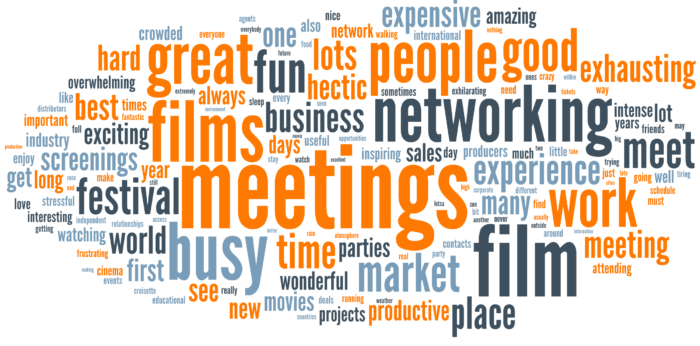
Further reading: Cannes film festival mysteries explained (via Nicolas Cage) and Ultimate tips for attending the Cannes Film Festival
5. There is a fairly even gender mix, although men hog the top jobs
Ten years ago, women accounted for 36% of people attending the Cannes market, whereas by 2018 this figure had risen to 45%. On the face of it, this is encouraging. It shows that we are getting close to equal representation and the trend is upward (albeit slowly). However, the devil is in the detail.
In Cannes in 2018, 35% of the high-status jobs were taken by women, along with 52% of mid-status jobs and 65% of low-status jobs.
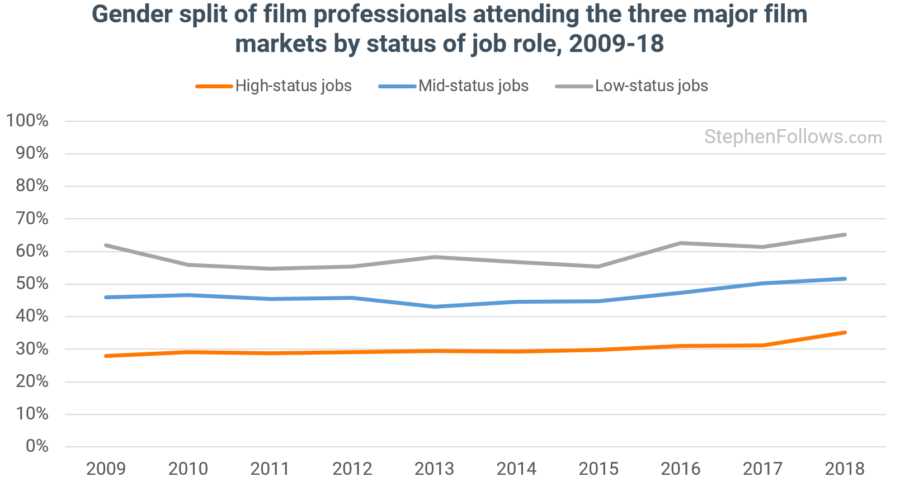
Female representation in high-status jobs is strongest among those working for film commissions and in publicity, whereas men dominate high-status jobs in distribution and production companies.
Cannes is a distillation of the best and worst of the film industry, crammed into a short period of time, in a small place and amped up to eleven. Therefore, it often features many of the seedier aspects of the industry. I have heard stories from female producers of how they are careful not to drink too much, not to get onto boats alone and to be wary of predatory men promising them the world. It would be naive to suggest that this will not be present at Cannes this year, but, hopefully, we will start to see the effects of #MeToo, Time’s Up and the Weinstein revelations on peoples’ behaviour.
Further reading: Gender diversity among film professionals working in sales and distribution
6. Plan for sun but be ready for rain
One of the nicest things about Cannes is that it takes place in the early summer in the south of France. As a result, it’s not uncommon for people to get sunburn while running between meetings. The average temperature during the Cannes film festival over the past decade was 17.7ºC (63.8ºF).
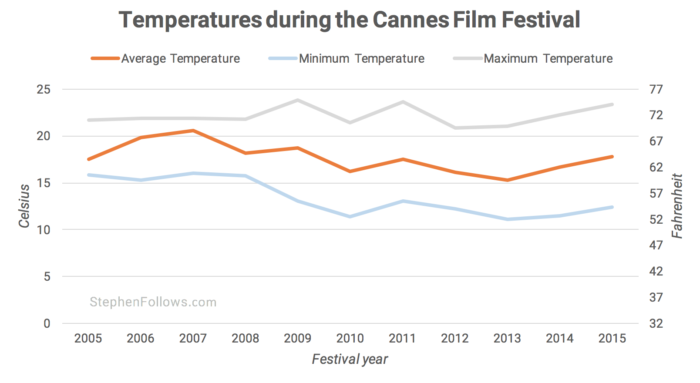
Over the past ten years, it has rained on 29% of festival days. The worst year of the past decade was 2012, which the Hollywood Reporter described as having a “London feel” due to the “rain, thunder and howling winds”.
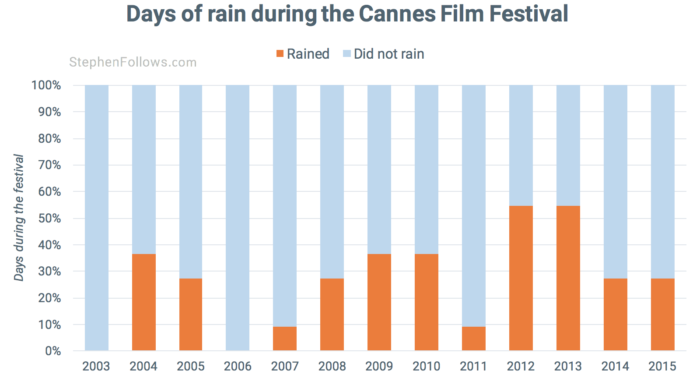
Further reading: Will it rain at the Cannes Film Festival?
7. The films in Cannes are likely to be French dramas, represented by Wild Bunch
The Cannes Film Festival is often referred to as the world’s top film festival, and therefore you might expect it to objectively treat films from all over the world equally. Not so. Between 2000 and 2015, 84% of nominees were dramas, 53% were French and 19% were sold by one company, Wild Bunch.
Another interesting trend is that English has become the most frequently used language among Cannes-nominated movies, due in part to an increase in French movies using English.
I have not watched every Cannes-nominated film (they’re next on my Netflix list after I finish Queer Eye) but I was able to get the official plot summaries for each from the Cannes website. By removing common English words (like, the, of, a, etc) we are able to get a snapshot of what is going on in Cannes nominated films (1939-2015) – the larger the word, the more popular it is.
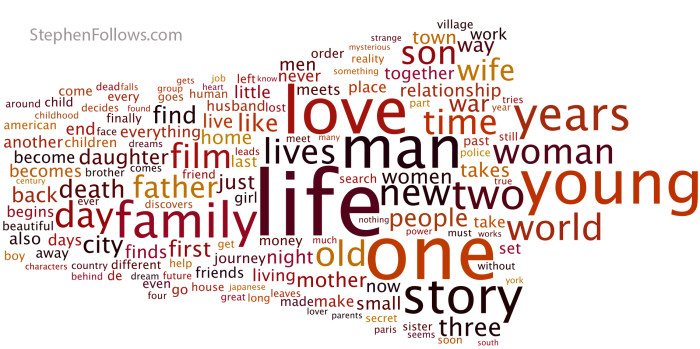
I used the data to generate the “perfect” Cannes movie, guaranteed to impress the jury. It’s a French drama called “Ma Vie Pour La Femme” (“My Life For The Woman”, for you English-speaking riff-raff), directed by Ken Loach and written by Jean-Claude Carrière. You can read more about this masterpiece, including the plot, here, in the section entitled ‘Building the perfect Palme d’Or winning film’.
Further reading: What types of films win the Palme d’Or at Cannes? Is English becoming the de facto language of Cannes films? and What do Cannes-nominated short films have in common?
8. The producers are angry, journalists contemptuous and publicists happy
Lastly, let’s end on some number-crunching fun. As a part of their registration at the market, film professionals can submit a photo to be publicly available in the physical guide and on the official site. Over 10,000 market attendees have done so, which made me think it would be fun to see what these photos can tell us about the types of people who attend Cannes.
I ran them through Microsoft’s Azure Emotion engine which I have previously used to catalogue emotion within movie posters. This tool can detect faces and measure levels of different key emotions (anger, contempt, disgust, fear, happiness, sadness and surprise). There’s more detail on my methodology in the write-up for my poster research, including a link to where you can try the tool for yourself.
Among the things I discovered was:
- Those working in production are the angriest, saddest and most fearful out of all Cannes attendees.
- The happiest photos were of those of people working in publicity and PR.
- Journalists are the most contemptuous, by a large margin.
- Journalists and distributors show zero fear and the lowest levels of surprise.
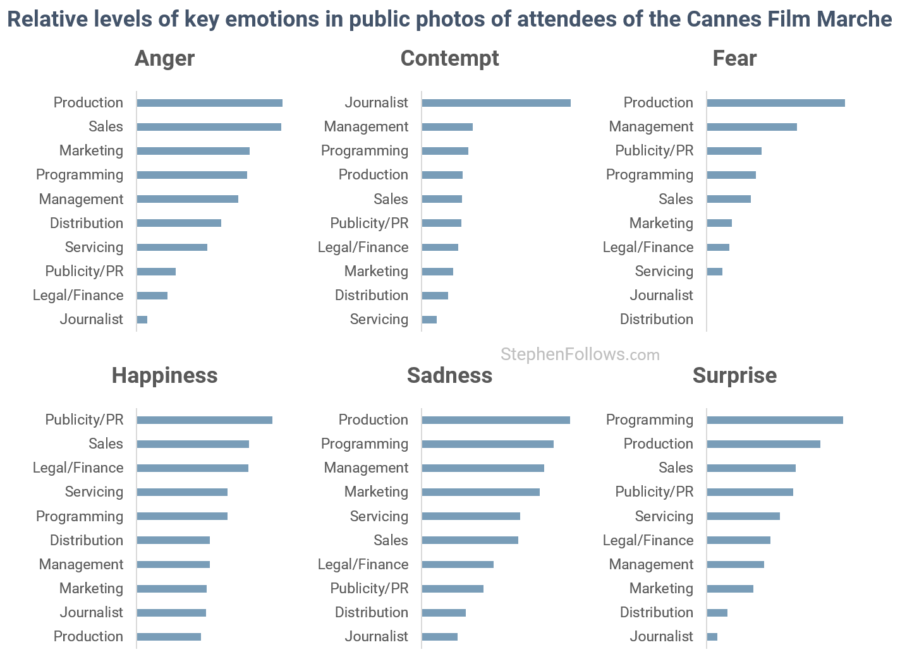
Obviously, this is just a bit of fun, rather than a profound look into people’s souls. The photo someone picks to be their headshot reveals the version of themselves that they want to put out into the world.
So if we’re being precise, we can’t say that people who work in PR are objectively happier than those in production, rather that their photos convey more happiness.
Further reading: Using facial recognition to track emotions on movie posters and Measuring actors’ brands via facial recognition
Notes
For each topic, I recommend following the link and reading the notes that go along with the research. This will allow you to understand the exact methodology, time-period and caveats for each.
Epilogue
As regular readers know, when I attend film markets I tend to keep a note of some of the most egregious bullshit I hear. So, for your delight and delectation, here are some choice phrases I have heard uttered in the UK pavilion during the Cannes Film Festival:
- “Stick it in a box and people will buy it” “Cool, so a physical release on DVD?” “No, a metaphorical box”
- “I’m doing a private screening this afternoon in my flat. I can see if I can squeeze you in, if you want to come?”
- [Two people who have made enthusiastic small talk for about ten minutes – about the weather, parties, films – and then they got onto what they do for a living. It turns out they’re both composers. The disappointment in both of them was palpable and they parted ways soon after]
- [Actor showing off about the films he’s been in] “And that film has just won an award at a major festival” “Which one?” “Best Editor”
- “Who’s directing?” “[Says a name] “Great, great, I totally respect him, totally. Would you consider changing to someone else?”
- “I love that party. Every year I go and get so much arse”
- “I’ve discovered that during Cannes is the worst time in the world to be trying to sell a film”
- “Your film is the exact type we finance” “So will you fund us?” “I’m afraid not”
- “And then we discovered that the producer had been lying to us the whole time” “So what did you do?” “Well, nothing, because to be fair to him we hadn’t really been telling him the truth either. Still, what a bastard!”
- “There’s two ways the script could go. Personally, I think the flashbacks slow the film down but we’re happy to do that if the investors want to spend more”
- “[Huge Hollywood star] is very interested. In fact, he’s completely ecstatic about the script and his agent said that he’s in as soon as we have the money for his quote”
- “There’s a big investor in the background of this one who is completely willing to fund it” “So it’s fully funded?” “Well, no, he wants to get other people to share the opportunity and he’ll be the last in”
- “I haven’t actually read the script but I really do think it could be the next ‘The King’s Speech’”
- “The good thing is that it’s the first of a planned trilogy”
- “We’ve had a breakdown of the special effects and amazingly it came in at just £5 million, which is less than half the total production budget”
- “It would be good to shoot in Asia so it will instantly have an original look. Or Malta”
- “This is going to be a very original Richard Curtis style rom-com”
- “It’s set in an ambiguously nowhere town but when you read the script it’s obviously London”

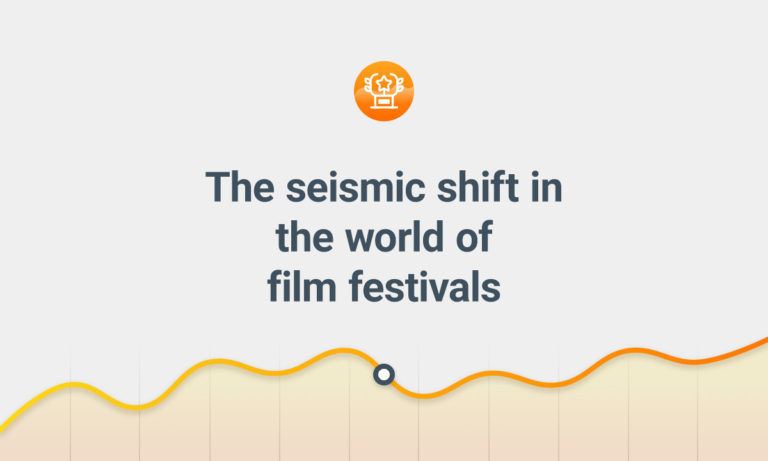
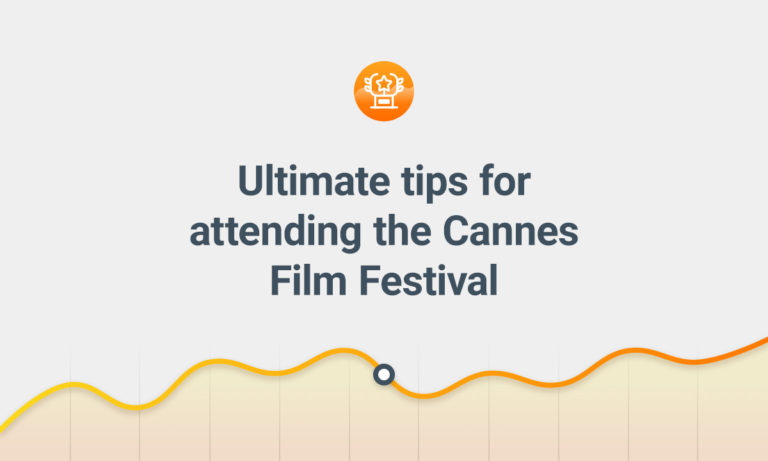
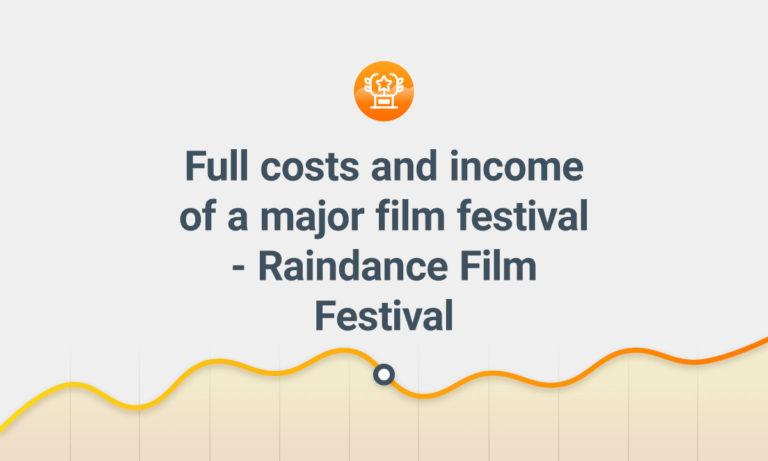

Comments
Haha – thanks – definitely made me laugh. See you in the thick of it x
Brilliant research as ever. I have a feeling I may end up a quote at the end of one of your articles.
Loved the dumb quotes at the end. Looking forward to one with BRILLIANT quotes.
If this is a true depiction of Cannes, where are the film festivals that do not have this going on?
Hi, first of all, the graphs are cool. Second, I collect data on Cannes Festal in favor of a design project that I do in school. It will be very helpful to me if I had the exact numerical data of the graph thatyou made about feelings of people according to pictures. Can I get this data from you? If not I would be happy if you could explain to me where I can find the pictures you used. I can not figure out where to find them on the website
Hi Stephen,
When referring to Cannes-nominated films, do you mean all of the Official Selection (main competition plus Un Certain Regard, Special Screenings, Out of Competition, etc.), or just the main competition? I’m thinking it must be the latter?
I’d be interested to see stats for the other official strands plus comparative successes of Directors Fortnight and Critics Week at some point – I’m always curious to understand how certain films end up in the different organisations’ selections and what this can mean for their eventual release.
Tom
Hi Tom. Yes, it’s usually the main competition, rather than also including the other sidebars. There should be a breakdown in the full article of each finding (in the ‘Further Reading’ bit). S
Please can you re-link the Wear comfy shoes but not at night article?
Thanks,
Thanks Stephen, you’re incredible for publishing these metrics.
How can we support you?